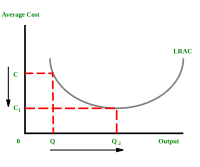
Photo from wikipedia
ABSTRACT Like other nations, Vietnam annually subsidies higher education via state budget to maintain academic operations of public institutions. However, the question of how to fairly and appropriately distribute state… Click to show full abstract
ABSTRACT Like other nations, Vietnam annually subsidies higher education via state budget to maintain academic operations of public institutions. However, the question of how to fairly and appropriately distribute state funding to public institutions is still challenging, therefore unfair distribution to some extent influence their cost efficiency. Using the quadratic cost function with random effects for a panel structure of 2011/12–2013/14, this paper aims to estimate economies of scale and scope of public universities and to seek for explaining whether the even application of standardized “one size fits all” policy in distributing public budget works or not when the cost analysis is stratified into rural and urban universities. The findings show that public universities are cost-inefficient in their performance and there are no economies of scale and scope in public universities. Even distribution of delivering state funding is more likely to be ineffective for public universities due to their different characteristics. Further, integrated teaching at various levels of higher education could be advantageous for rural universities but might not to be the case for their urban counterparts. In the end, policy implications for ameliorating the performance of public institutions are suggested.
Journal Title: Asia Pacific Journal of Education
Year Published: 2020
Link to full text (if available)
Share on Social Media: Sign Up to like & get
recommendations!